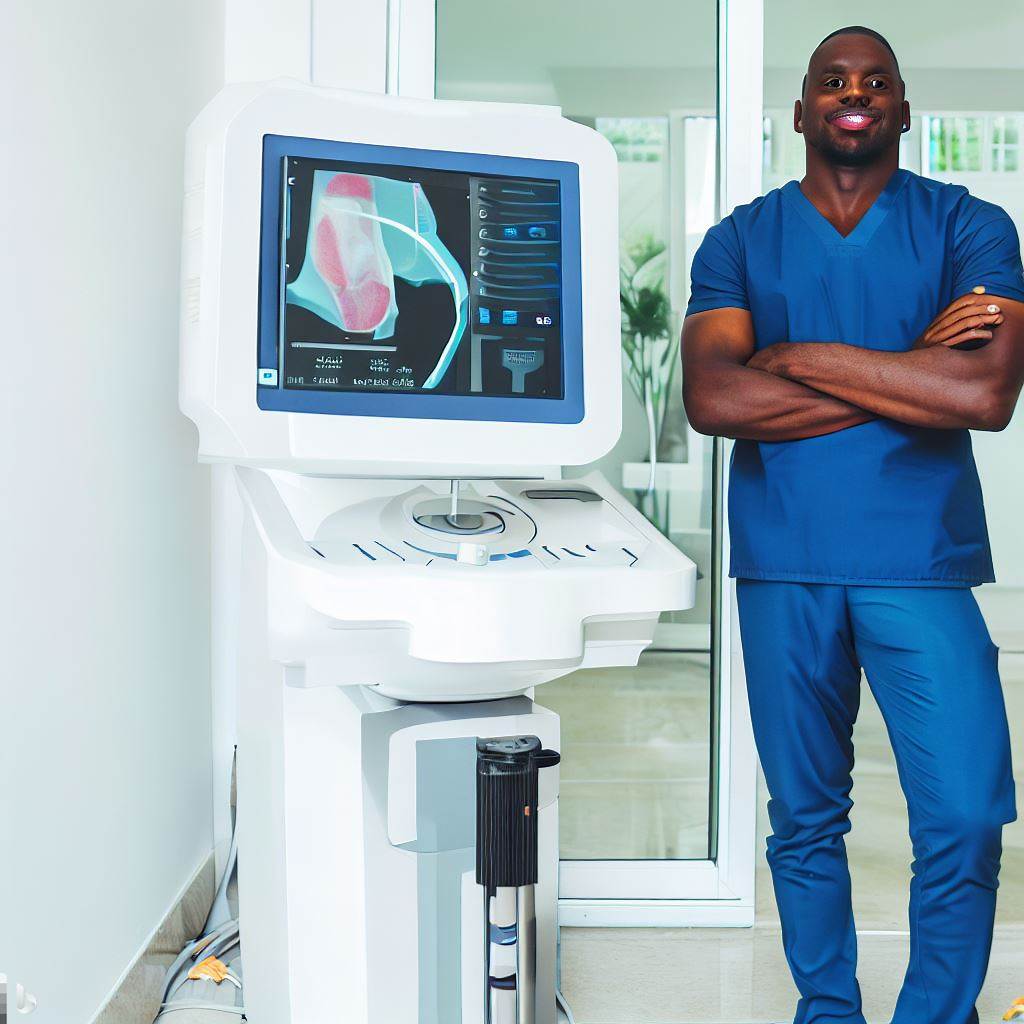Introduction
In this section, we will explore the definitions and scopes of practice for podiatrists and orthopedists.
Both specialties play a crucial role in the field of medicine, but they have distinct focuses and responsibilities. Let’s dive into the details!
Importance of discussing the topic from a Nigerian perspective
Medical specialists in podiatry and orthopedics diagnose and treat foot and ankle disorders, along with conditions involving bones, joints, muscles, ligaments, and tendons.
Both fields focus on ensuring proper functionality and mobility of the lower extremities.
However, it is important to discuss this topic from a Nigerian perspective due to the unique healthcare challenges faced in the country.
With a population surpassing 200 million, Nigeria faces heightened foot and ankle issues, attributed to limited awareness and healthcare access.
The country also grapples with a shortage of healthcare professionals, including podiatrists and orthopedists.
Consequently, inadequate or incorrect treatments in Nigeria lead to preventable complications and disabilities among many individuals.
By comparing Nigerian podiatrists and orthopedists, we illuminate the significance of holistic foot and ankle treatment in the nation.
This discussion seeks to raise awareness about consulting the right medical experts for distinct foot and ankle issues.
In the next section, we’ll explore the required education for podiatrists and orthopedists, the range of treated conditions, and the benefits of timely specialized care.
We will also address misconceptions surrounding these specialties and highlight the need for increased resources and support in the Nigerian healthcare system.
Exploring podiatrists vs. orthopedists in Nigeria aims to foster understanding, increase awareness, and push for better foot care nationwide.
In this section, we will explore the definitions and scopes of practice for podiatrists and orthopedists.
Both specialties play a crucial role in the field of medicine, but they have distinct focuses and responsibilities. Let’s dive into the details!
Distinguishing factors between podiatrists and orthopedists
- While podiatrists primarily focus on foot and ankle conditions, orthopedists have a broader scope that covers the entire musculoskeletal system.
- Specialized training focuses on foot and ankle intricacies, giving podiatrists profound, area-specific knowledge and equipping them effectively.
- Orthopedists receive thorough training in diverse musculoskeletal issues, enabling them to address body-wide disorders effectively.
- Podiatrists, with their specialization, can frequently spot systemic diseases like diabetes or circulatory disorders, which show symptoms in feet.
- Orthopedists generally handle more complex cases involving multiple areas of the body, such as complex fractures, bone tumors, or spinal deformities.
- Podiatrists and orthopedists collaborate, offering specialized care for patients with foot or musculoskeletal conditions, despite overlapping expertise.
Definition and scope of practice for podiatrists
- Podiatrists, also known as foot doctors, specialize in diagnosing and treating conditions related to the feet, ankles, and lower limbs.
- They possess extensive knowledge and expertise in foot anatomy, biomechanics, and podiatric medicine.
- Trained podiatrists handle foot problems, including injuries, arthritis, sports-related issues, diabetic foot care, and perform surgeries.
- They may utilize diagnostic tools and techniques like X-rays, ultrasounds, and laboratory tests to assess and diagnose foot and ankle problems accurately.
- Podiatrists collaborate with patients, offering preventive care, devising treatment strategies, prescribing medicines, and suggesting orthotic tools or aids.
- Furthermore, they might partner with orthopedic surgeons and physical therapists, ensuring holistic and complete patient care collaboration.
Definition and scope of practice for orthopedists
- Medical doctors specializing in treating musculoskeletal issues involving bones, muscles, tendons, ligaments, and joints are orthopedists.
- With comprehensive musculoskeletal knowledge, they excel in surgical and non-surgical orthopedic treatments.
- Orthopedists frequently address fractures, sports injuries, joint disorders, tendon tears, spinal issues, and congenital abnormalities.
- They utilize advanced imaging techniques, such as MRI or CT scans, to accurately diagnose and assess orthopedic conditions.
- Orthopedists create individualized treatment plans, incorporating surgery when needed, and supervise orthopedic recovery routines.
- They work closely with physical therapists, occupational therapists, and other healthcare professionals to maximize patients’ recovery and improve their quality of life.
Podiatrists and orthopedists differ in their specialty focuses and scopes of practice.
Podiatrists concentrate on foot and ankle conditions, while orthopedists cover a broader range of musculoskeletal disorders.
Both specialties actively enhance patients’ well-being, collaborating to improve mobility, alleviate pain, and enhance overall health within healthcare.
Read: Case Studies: The Role of Social Workers in Nigerian Communities
Education And Training
Podiatry education and training requirements
- In Nigeria, to become a podiatrist, one must first obtain a bachelor’s degree in a science-related field.
- After completing the undergraduate degree, aspiring podiatrists must enroll in a Doctor of Podiatric Medicine (DPM) program.
- The DPM program usually takes four years to complete and includes both classroom lectures and clinical rotations.
- During their training, podiatry students learn about the anatomy, physiology, and biomechanics of the foot and ankle.
- They also gain knowledge and skills in diagnosing and treating various foot and ankle conditions, including injuries, infections, and deformities.
- Podiatry students receive hands-on training through clinical experiences, where they work under the supervision of experienced podiatrists.
- After completing the DPM program, graduates must pass the Podiatry License Examination to become licensed practitioners.
Orthopedic education and training requirements
- To become an orthopedist in Nigeria, one must first obtain a bachelor’s degree in medicine or surgery (MBBS).
- After completing the MBBS degree, aspiring orthopedic surgeons must undertake a mandatory one-year internship program.
- Following the internship, doctors interested in specializing in orthopedics must apply for a residency program in orthopedic surgery.
- The orthopedic residency program typically takes five to six years to complete.
- During their residency, orthopedic residents gain comprehensive training in various aspects of musculoskeletal care.
- They learn about the diagnosis, treatment, and prevention of conditions affecting the bones, joints, muscles, ligaments, and tendons.
- The training also includes learning surgical techniques and procedures for both pediatric and adult patients.
- Orthopedic residents work under the guidance of experienced orthopedic surgeons, and gradually gain more autonomy as they progress in their training.
- After completing the residency program, doctors must pass the Orthopedic and Trauma Surgery Fellowship Examination to become certified orthopedic surgeons.
Comparison of duration and curriculum
- The duration of podiatry education and training, including the DPM program, is typically around four years.
- Podiatry students focus specifically on the foot and ankle, deepening their understanding of this specialized area.
- The curriculum emphasizes the diagnosis and treatment of foot and ankle disorders, as well as preventive care.
- On the other hand, orthopedic education and training spans a longer duration of approximately six years.
- Orthopedic residents receive a more comprehensive education on the musculoskeletal system as a whole.
- The curriculum covers a wide range of orthopedic specialties, including spine, sports medicine, trauma, and joint replacements.
- Orthopedic surgeons have a broader scope of practice and can treat conditions affecting various parts of the body.
- Both podiatrists and orthopedic surgeons undergo extensive clinical training to develop the necessary skills for their respective fields.
The education and training paths for podiatrists and orthopedists in Nigeria differ in their requirements, duration, and curriculum.
Podiatrists specifically focus on the foot and ankle, while orthopedic surgeons receive a more comprehensive education on the musculoskeletal system.
Both professions play crucial roles in providing specialized care to patients, ensuring their mobility and overall well-being.
Read: How Podiatrists Improve Public Health in Nigeria

Treatment Approach
When it comes to the treatment approach, podiatrists and orthopedists have different focuses.
1. Podiatrists’ focus on foot and ankle health
- Diagnosing and treating conditions specifically related to the foot and ankle.
- Performing surgeries to correct foot and ankle deformities or injuries.
- Prescribing custom orthopedics to provide support and alleviate pain in the feet and ankles.
- Treating common foot problems such as corns, calluses, ingrown toenails, and fungal infections.
- Providing preventive care and advice on proper foot care and footwear choices.
2. Orthopedists’ broader focus on the musculoskeletal system
- Diagnosing and treating conditions affecting the entire musculoskeletal system, including the bones, joints, ligaments, tendons, and muscles.
- Performing surgeries related to the musculoskeletal system, such as joint replacements and fracture repairs.
- Prescribing medications, physical therapy, and other non-surgical treatments to manage orthopedic conditions.
- Treating sports injuries, such as torn ligaments and fractures.
- Providing specialized care for conditions like arthritis, scoliosis, and osteoporosis.
Both podiatrists and orthopedists perform a range of common treatments and procedures:
Examples Of Common treatments and procedures performed by both professions
- X-rays and other diagnostic imaging to identify the extent of injuries or abnormalities.
- Casting or splinting to immobilize fractured bones or stabilize joint injuries.
- Physical therapy to improve strength, flexibility, and mobility.
- Prescription of pain medications and anti-inflammatory drugs to alleviate pain and reduce inflammation.
- Injection of corticosteroids or other medications to address localized pain or inflammation.
- Recommendations for lifestyle modifications, such as weight loss or exercise, to improve overall musculoskeletal health.
- Collaboration with other healthcare professionals, such as physical therapists or rehabilitation specialists, for comprehensive patient care.
Yet, remember that podiatrists address foot problems; they also team up with orthopedists for intricate musculoskeletal cases.
In Nigeria, podiatrists address foot and ankle problems like bunions. Orthopedists handle fractures, joint problems, and musculoskeletal issues.
Podiatrists in Nigeria typically see patients who present with foot and ankle problems.
These can include conditions such as ingrown toenails, corns, calluses, and fungal infections.
They also treat more complex issues like bunions, plantar fasciitis, and diabetic foot ulcers.
Orthopedists, on the other hand, treat patients with a broader range of musculoskeletal conditions.
They see patients with fractures, dislocations, and sprains, as well as joint problems like arthritis and tendonitis.
Orthopedists also help manage degenerative conditions like osteoporosis and perform joint replacement surgeries.
When it comes to common conditions treated by each profession, there is some overlap.
For example, both podiatrists and orthopedists may treat patients with ankle sprains or fractures.
Podiatrists specialize in treating foot and ankle issues; orthopedists focus on the entire musculoskeletal system.
Podiatrists often work closely with diabetic patients to manage foot complications related to their condition.
They may provide preventive foot care and education on proper footwear and foot hygiene.
Orthopedists, on the other hand, may focus more on surgical interventions for complex injuries or conditions requiring joint replacement.
Due to Nigeria’s rising population and musculoskeletal problems, the country requires more podiatrists and orthopedists.
However, there is a shortage of trained professionals in both fields, leading to longer wait times for patients seeking specialized care.
In summary, podiatrists in Nigeria primarily see patients with foot and ankle conditions, while orthopedists treat a wider range of musculoskeletal issues.
Both professions have their own areas of expertise and play crucial roles in managing and treating various conditions.
As the demand for specialized care continues to rise, it is important to address the shortage of trained professionals in these fields.
Patient Population and Conditions Treated
In Nigeria, podiatrists primarily see patients with foot and ankle conditions, such as bunions and plantar fasciitis. Orthopedists, on the other hand, treat a wide range of musculoskeletal issues, including fractures and joint problems.
Typical patients seen by podiatrists
Podiatrists in Nigeria typically see patients who present with foot and ankle problems. These can include conditions such as ingrown toenails, corns, calluses, and fungal infections. They also treat more complex issues like bunions, plantar fasciitis, and diabetic foot ulcers.
Typical patients seen by orthopedists
Orthopedists, on the other hand, treat patients with a broader range of musculoskeletal conditions. They see patients with fractures, dislocations, and sprains, as well as joint problems like arthritis and tendonitis. Orthopedists also help manage degenerative conditions like osteoporosis and perform joint replacement surgeries.
Comparison Of Common Conditions Treated By Each Profession
When it comes to common conditions treated by each profession, there is some overlap.
For example, both podiatrists and orthopedists may treat patients with ankle sprains or fractures.
However, podiatrists are more specialized in treating foot and ankle conditions, while orthopedists have a broader focus on the musculoskeletal system as a whole.
Podiatrists often work closely with diabetic patients to manage foot complications related to their condition.
They may provide preventive foot care and education on proper footwear and foot hygiene.
Orthopedists, on the other hand, may focus more on surgical interventions for complex injuries or conditions requiring joint replacement.
In Nigeria, there is a growing demand for both podiatrists and orthopedists due to the country’s increasing population and prevalence of musculoskeletal issues.
However, there is a shortage of trained professionals in both fields, leading to longer wait times for patients seeking specialized care.
In summary, podiatrists in Nigeria primarily see patients with foot and ankle conditions, while orthopedists treat a wider range of musculoskeletal issues.
Both professions have their own areas of expertise and play crucial roles in managing and treating various conditions.
As the demand for specialized care continues to rise, it is important to address the shortage of trained professionals in these fields.
Read: An Overview of Social Work Practices in Nigeria
Access to Care in Nigeria
- The availability and accessibility of podiatrists in Nigeria is limited.
- There is a scarcity of orthopedists in Nigeria, making it difficult for patients to access specialized foot and ankle care.
- The challenges in accessing specialized foot and ankle care in Nigeria are numerous and significant.
1. Availability and accessibility of podiatrists
In Nigeria, there is a substantial shortage of podiatrists.
This scarcity poses a significant challenge for individuals seeking specialized foot and ankle care.
The limited number of podiatrists makes it challenging for patients to find a professional who can address their specific needs effectively.
Consequently, individuals with foot and ankle issues often encounter delays in receiving appropriate care.
2. Availability and accessibility of orthopedists
Similarly, the availability of orthopedists in Nigeria is also limited.
Orthopedists play a crucial role in the diagnosis and treatment of foot and ankle disorders.
However, due to the scarcity of orthopedists in the country, accessing specialized care becomes a daunting task for patients.
This inadequacy in the healthcare system leaves individuals with foot and ankle problems without proper medical attention.
3. Challenges in accessing specialized foot and ankle care
- Geographical limitations: Nigeria is a vast country with a significant population dispersed across different regions.
Specialized foot and ankle care centers concentrate in urban areas, hindering rural individuals’ access to services..
The distance and lack of transportation options act as barriers, preventing patients from receiving the care they urgently require. - Financial constraints: Affordability poses another major obstacle to accessing specialized foot and ankle care.
Consultations, tests, medications, and surgeries become expensive, barring many Nigerians from access due to financial constraints.
The lack of adequate health insurance coverage further exacerbates the financial burden faced by patients seeking specialized care. - Long waiting times: Due to the scarcity of podiatrists and orthopedists, patients often face long waiting times to receive specialized foot and ankle care.
Treatment delays worsen patients’ conditions, escalate symptoms, and foster complications, compromising their well-being significantly.
The prolonged waiting times hinder timely intervention and can negatively impact the overall prognosis of foot and ankle disorders. - Limited awareness and education: Many Nigerians are unaware of the importance of specialized foot and ankle care and the existence of podiatrists.
Limited awareness prompts seeking unconventional treatments or delaying medical help until conditions deteriorate.
This lack of awareness perpetuates the challenges in accessing specialized care and reduces the available options for patients in need.
Accessing specialized foot and ankle care in Nigeria is a significant challenge due to the limited availability and accessibility of podiatrists and orthopedists.
Geographical limits, financial constraints, lengthy waits, and low awareness impede patients from promptly accessing suitable foot and ankle disorder care.
To address these challenges, we need to invest in healthcare, train more professionals, and enhance public education.
Read: Economic Impact of Podiatry in Nigeria’s Healthcare
Collaborative Approach in Patient Care
Importance of interdisciplinary collaboration
- Improved patient outcomes: When podiatrists and orthopedists work together, patients receive comprehensive care, leading to better outcomes.
- Enhanced treatment planning: Collaboration allows for a more holistic approach to treatment planning, considering all aspects of a patient’s condition.
- Efficient utilization of resources: By combining their expertise, podiatrists and orthopedists can optimize the use of available resources.
Cases where podiatrists and orthopedists may collaborate
- Diabetic foot complications: Diabetic patients with foot ulcers or neuropathy often require both specialists to manage their condition effectively.
- Sports-related injuries: Podiatrists and orthopedists can collaborate to provide comprehensive care for athletes with foot and ankle injuries.
- Charcot foot syndrome: This complex condition often requires a multidisciplinary team approach, involving both podiatrists and orthopedists.
Benefits of a combined treatment approach
- Comprehensive evaluation: Integrating the knowledge and skills of both specialists ensures a thorough evaluation of the patient’s condition.
- Tailored treatment plans: Collaborating allows for the development of personalized treatment plans that take into account individual patient needs.
- Holistic approach: A combined treatment approach considers both the immediate symptoms and the underlying causes, leading to more effective care.
- Minimized risks: Collaboration helps in identifying potential risks and complications early, leading to timely interventions and improved patient safety.
- Patient-centered care: A collaborative approach ensures that the patient’s preferences, goals, and values are considered throughout the treatment process.
- Shared expertise: Podiatrists and orthopedists bring different perspectives and skills, enhancing the overall quality of care provided to patients.
- Efficient coordination of care: Collaboration between podiatrists and orthopedists facilitates seamless communication and coordination for optimal patient care.
Podiatrists and orthopedists collaborating enhance outcomes, optimize resources, and offer tailored treatment plans for patients’ comprehensive care.
Through interdisciplinary collaboration, patients receive holistic care that addresses their unique needs, resulting in better overall outcomes.
The shared expertise and efficient coordination further contribute to the success of combined treatment approaches.
Cultural Factors and Preferences
When it comes to seeking treatment for foot and ankle conditions, cultural factors play a significant role in Nigeria.
Understanding and addressing these factors can help promote acceptance and awareness of specialized foot and ankle care.
Influence of cultural factors on treatment-seeking behavior
- Cultural beliefs and traditions heavily influence how Nigerians approach healthcare.
- Some people in Nigeria may initially prefer seeking treatment from traditional healers due to cultural beliefs.
- Misconceptions about foot and ankle conditions may lead to delayed or incorrect treatment seeking in some cases.
- Lack of awareness about the benefits of podiatry and orthopedics among certain populations.
- Reliance on self-medication or alternative therapies due to cultural preferences and distrust in modern medicine.
Preferences for traditional healers or alternative therapies in Nigeria
- Traditional healers, such as herbalists and spiritual healers, are often seen as alternative options for foot and ankle care.
- These healers are believed to possess traditional knowledge and remedies passed down through generations.
- Many Nigerians have an inherent trust in these traditional healing practices due to cultural upbringing.
- Alternative therapies like acupuncture and chiropractic treatments also attract some individuals seeking non-conventional options.
- Cost-effectiveness and accessibility of traditional healers and alternative therapies may also influence preferences.
Encouraging acceptance and awareness of specialized foot and ankle care
- Educating the Nigerian population about the importance of proper foot and ankle care is essential.
- Raising awareness about the expertise and qualifications of podiatrists and orthopedists can help debunk misconceptions.
- Collaborating with traditional healers to bridge the gap between traditional and modern healthcare practices.
- Promoting community outreach programs to provide free or affordable foot and ankle screenings and treatments.
- Emphasizing the effectiveness and evidence-based nature of specialized care through public health campaigns.
Cultural factors significantly impact treatment-seeking behavior in Nigeria regarding foot and ankle conditions.
Recognizing the influence of cultural beliefs and preferences is crucial in promoting acceptance and awareness of specialized foot and ankle care.
By tackling these factors, Nigeria can narrow the divide between traditional healing and modern medicine, ultimately enhancing population foot and ankle health.
Conclusion
The comparison between podiatrists and orthopedists in Nigeria reveals that both professions play a crucial role in providing specialized foot and ankle care.
Podiatrists focus solely on lower extremity issues, while orthopedists address a broader range of musculoskeletal problems.
In this blog, we’ve covered key points: educational needs, training, and practice scope for podiatrists and orthopedists.
We have also examined the challenges faced by Nigerian patients in accessing specialized foot and ankle care.
It is evident that both podiatrists and orthopedists have significant value in addressing and treating foot and ankle conditions in Nigeria.
By working together, they can provide comprehensive care and improve the overall health outcomes for patients.
Therefore, a call-to-action is necessary to ensure improved access to specialized care.
This includes advocating for increased funding and resources to support the training and development of podiatrists.
Additionally, there should be efforts to enhance collaboration and communication between podiatrists and orthopedists to provide integrated care.
The collaboration between podiatrists and orthopedists is essential for delivering effective foot and ankle care in Nigeria.
By acknowledging the worth of both professions and taking proactive measures, we can shape a healthcare system suiting lower extremity conditions.




